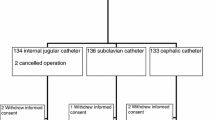Abstract
A group of 43 adult patients with acute leukaemia (AL) were randomized to receive a double-lumen totally implantable subcutaneous port system (PORT, n=19) or a double-lumen central venous catheter (CVC, n=24) before induction chemotherapy. Six patients were excluded due to protocol violation (n=4, CVC) and technical difficulties (n=2, PORT). A standardized catheter record form was used for recording of catheter function, local infection and bleeding. The study was prematurely closed due to extensive subcutaneous bleeding after placement in five patients with a PORT. Intention to treat (n=43) or per protocol (PP) analysis (n=37) did not reveal a significant difference between the two groups with regard to catheter survival time (PP PORT, median 113 days, range 2–634 days; CVC, 55 days, 11–223 days). The number of positive blood cultures per 100 central venous access device days was significantly higher in the CVC group (median 3.6 per 100 days) than in the PORT group (0.9 per 100 days; P=0.02). In addition, the time to the first blood culture positive for coagulase-negative staphylococcus was shorter in the CVC group (median 14 days) than in the PORT group (52 days; P=0.02). Despite fewer infectious complications in the PORT group the use of a double-lumen CVC is advocated in patients with AL undergoing induction treatment due to the risk of extensive local bleeding after placement of the PORT.


Similar content being viewed by others
References
Biffi R, de Braud F, Orsi F, et al (1998) Totally implantable central venous access ports for long-term chemotherapy. A prospective study analyzing complications and costs of 333 devices with a minimum follow-up of 180 days. Ann Oncol 9:767–773
Björkholm M (1994) Chemoprophylaxis of fungal infections in neutropenic patients. Ann Oncol 5:571–574
Bodey GP, Buckley M, Sathe YS, Freireich EJ (1966) Quantitative relationships between circulating leukocytes and infection in patients with acute leukemia. Ann Intern Med 64:328–340
Brincker H, Saeter G (1986) Fifty-five patient years’ experience with a totally implanted system for intravenous chemotherapy. Cancer 57:1124–1129
Carde P, Cosset-Delaigue M, Laplanche A, Chareau I (1989) Classical external indwelling central venous catheter versus totally implanted venous access systems for chemotherapy administration: a randomized trial in 100 patients with solid tumours. Eur J Cancer Clin Oncol 25:939–944
Engervall P, Björkholm M (1995) Infections in neutropenic patients I: aetiology. Med Oncol 12:251–256
Engervall P, Ringertz S, Hagman E, et al (1995) Change of central venous catheter dressings twice a week is superior to once a week in patients with haematological malignancies. J Hosp Infect 29:275–286
Engervall P, Gunther G, Ljungman P, et al (1996) Trimethoprim-sulfamethoxazole plus amikacin versus ceftazidime monotherapy as empirical treatment in patients with neutropenia and fever. Scand J Infect Dis 28:297–303
Groeger J, Lucas A, Thaler H, et al (1993) Infectious morbidity associated with long-term use of venous access devices in patients with cancer. Ann Intern Med 119:1168–1174
Hartkamp A, Boxtel A, Zonnenberg B, Witteven P (2000) Totally implantable venous access devices: evaluation of complications and a prospective comparative study of two different port systems. Neth J Med 57:215–223
Kaplan E, Meier P (1958) Nonparametric estimation from incomplete observations. J Am Stat Soc 53:457–481
Kappers-Klunne M, Degener J, Stijnen T, Abels J (1989) Complications from long-term indwelling central venous catheters in hematologic patients with special reference to infection. Cancer 64:1747–1752
Kock H, Pietsch M, Krause U, et al (1998) Implantable vascular access systems: experience in 1500 patients with totally implanted central venous port systems. World J Surg 22:12–16
Mueller B, Skelton J, Callender D, et al (1992) A prospective randomized trial comparing the infectious and noninfectious complications of an externalized catheter versus a subcutaneously implanted device in cancer patients. J Clin Oncol 10:1943–1948
O’Grady NP, Alexander M, Dellinger EP, et al (2002) Guidelines for the prevention of intravascular catheter-related infections. Centers for Disease Control and Prevention. MMWR Recommendations and Reports, vol 51, no. RR10;1, pp 1–26
Pagano L, Taconelli E, Tumbarello M, et al (1997) Bacteremia in patients with hematological malignancies. Analysis of risk factors, etiological agents and prognostic indicators. Haematologica 82:415–419
Peto R, Pike MC, Armitage P, et al (1977) Design and analysis of randomized clinical trials requiring prolonged observation of each patient. II. Analysis and examples. Br J Cancer 35:1–39
Peuges D, Axelrod P, McClarren C, et al (1992) Comparison of infections in hickman and implanted port catheters in adult solid tumor patients. J Surg Oncol 49:156–162
Platzbecker U, Illmer T, Schaich M, et al (2001) Double lumen port access in patients receiving allogeneic blood stem cell transplantation. Bone Marrow Transplant 28:1067–1072
Raad I, Baba M, Bodey G (1995) Diagnosis of catheter-related infections: the role of surveillance and targeted quantitative skin cultures. Clin Infect Dis 20:593–597
Reilly J, Steed D, Ritter P (1984) Indwelling venous access catheters in patients with acute leukemia. Cancer 53:219–223
Schiffer CA, Anderson KC, Bennett CL, et al (2001) Platelet transfusion for patients with cancer: clinical practice guidelines of the American Society of Clinical Oncology. J Clin Oncol 19:1519–1538
Soo KC, Davidson TI, Selby P, Westbury G (1985) Long-term venous access using a subcutaneous implantable drug delivery system. Ann R Coll Surg Engl 67:263–265
Acknowledgements
This study was supported by grants from the Swedish Cancer Society and the Stockholm County Council. The authors wish to thank Jan Jacobson and Peter Löthman, anaesthesiologists who contributed to the initial planning of this study. Mariette Åkermark (technical assistance) and Bo Nilsson (statistical advice) are also gratefully acknowledged.
Author information
Authors and Affiliations
Corresponding author
Rights and permissions
About this article
Cite this article
Johansson, E., Björkholm, M., Björvell, H. et al. Totally implantable subcutaneous port system versus central venous catheter placed before induction chemotherapy in patients with acute leukaemia—a randomized study. Support Care Cancer 12, 99–105 (2004). https://doi.org/10.1007/s00520-003-0558-1
Received:
Accepted:
Published:
Issue Date:
DOI: https://doi.org/10.1007/s00520-003-0558-1




